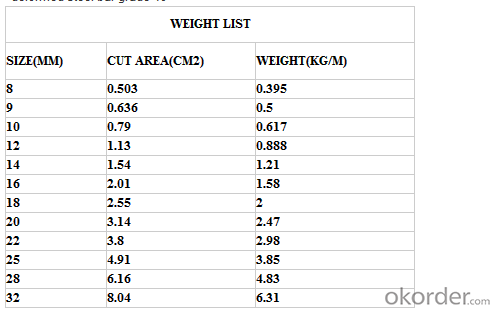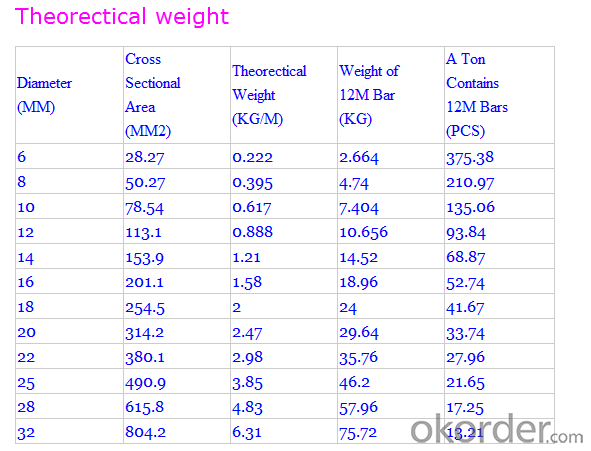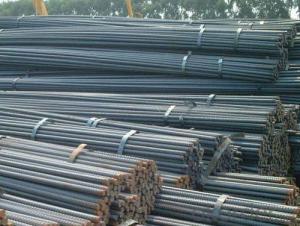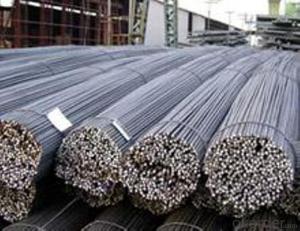BS4449 G460 Reinforcing Deformed Steel Bar, Rebar, Deformed Rebar
- Loading Port:
- Shanghai
- Payment Terms:
- TT OR LC
- Min Order Qty:
- 100 m.t.
- Supply Capability:
- 1000 m.t./month
OKorder Service Pledge
OKorder Financial Service
You Might Also Like
deformed steel bar grade 40
material: HRB400, BS4449 GR460B
size: 8-36mmx12m.
short delivery time by bulk or container
deformed steel bar grade 40
material: HRB400, BS4449 GR460B
size: 8-36mmx12m.
short delivery time with bulk or container
packing: Mill standard export packing in bundles/coil, around 2tons/bundle.
country of Origin: China
delivery Time: Within a 35 days
Shipment: by bulk vessel or by container

Leading goods:
section steel:angles,channels,I-beam,H-beam;
coils:cold/hot rolled coils,PPGI,galvanized coils,plate,checkered plate,cutting steel plate,steel strip;
wire rod:steel wire,deformed wire,bar;
pipe:seamless pipe,rectangular pipe,welded pipe,spiral welded pipe,pipe fittings;
stainless steel:steel sheets,stainless steel strips,stainless bar,stainless tube;
special:weathering steel,shipbuilding steel;
construction steel:C-channel,Z-channel,T-bar,high-speed divider plate,corrugated steel plate,steel grating.
Advantage:
We are the spot supplier, Six huge warehouses which can hold 20,000 MT goods.
It makes the cost lower than others,we can provide the competitive price for you.
Delivery time:
Normal sizes can be provided in 7days, the others should be ready in 30---45 days.
Further treatment:
We can offer cutting,painting,drilling holes,bending,threading, welding,galvanization,packing etc.
Security interest:
We have already passed the ISO9001, BV and SGS authentication which makes the quality secured.
If you have the interest in any of the products we can provided, pls don't hesitate to connect with me. Looking forward to cooperate with you.

FAQ of Steel Deformed Bar
1. More than 10 years experience in this industry
2. 100,000 tons exporting per month
3. Professional foreign trade tea
4. OEM&ODM capacity
5. High quality assured & competitive price
6. Try our best to meet your needs & save your budget
7. Very popular in Southeast Asia, Africa, Mid-East and South America etc.
8. VIP membership system, first time customers and long-term cooperation customers can get extra discount on some products.
- Q:Can steel rebars be used in seismic-resistant structures?
- Seismic-resistant structures can indeed incorporate steel rebars. These rebars possess remarkable tensile strength and ductility, rendering them a perfect choice for reinforcing concrete structures in regions susceptible to earthquakes. By implementing them in a well-designed and properly installed manner, steel rebars significantly enhance the structural integrity and resilience of buildings against seismic forces. They furnish concrete with added strength and flexibility, enabling it to endure lateral and vertical loads exerted during an earthquake more effectively. Additionally, steel rebars proficiently disperse and absorb the energy generated during seismic events, thereby diminishing the risk of structural harm or collapse.
- Q:Can steel rebars be used in underground construction or tunnels?
- Yes, steel rebars can be used in underground construction or tunnels. Steel rebars are commonly used in these applications to provide strength and reinforcement to concrete structures, ensuring their stability and durability in challenging underground environments.
- Q:Are steel rebars suitable for use in high-temperature applications?
- High-temperature applications are generally not suitable for the use of steel rebars. Despite being a strong and durable material, steel has limitations when exposed to high temperatures. It can undergo a significant reduction in strength and even a loss of structural integrity, leading to potential failures. When subjected to high temperatures, steel goes through a process known as thermal expansion, which can weaken and deform it. This phenomenon is particularly noticeable in rebars, which are commonly used to reinforce concrete structures. The high temperatures cause the rebars to expand, exerting excessive pressure on the surrounding concrete. This pressure can result in cracks and potentially compromise the stability of the structure. Furthermore, prolonged exposure to high temperatures can cause a loss of the steel's mechanical properties, including its tensile strength and load-bearing capacity. As a result, the rebars become less effective in resisting external forces and reinforcing the concrete. For this reason, it is generally recommended to consider alternative materials, such as stainless steel or special alloys, for high-temperature applications. These materials are specifically designed to withstand elevated temperatures without compromising their structural integrity. To ensure safety and structural stability, it is important to consult with experts and engineers who are familiar with high-temperature applications in order to determine the most suitable materials for specific projects.
- Q:What is the standard size of a steel rebar?
- The standard size of a steel rebar can vary depending on the specific application and project requirements. However, in construction and civil engineering, the most commonly used standard sizes for steel rebars are typically 10mm, 12mm, 16mm, 20mm, 25mm, and 32mm in diameter. These sizes are widely available and are used in various structural elements such as beams, columns, and slabs. Additionally, the length of a steel rebar can vary, typically ranging from 6 meters to 12 meters, depending on the project specifications. It is important to consult the project engineer or refer to the relevant building codes and standards to determine the appropriate size of steel rebar for a specific construction project.
- Q:Can steel rebars be used in heritage building restoration?
- Yes, steel rebars can be used in heritage building restoration. They are commonly used to reinforce and strengthen the structural integrity of old buildings, helping to preserve their historical significance and ensure their longevity.
- Q:What is the maximum spacing allowed between steel rebars in a concrete structure?
- The maximum spacing allowed between steel rebars in a concrete structure depends on various factors such as the type of structure, its intended use, and the design specifications. Generally, the maximum spacing is determined by the structural engineer and is based on the required structural integrity, load-bearing capacity, and other relevant considerations.
- Q:What are the advantages of using galvanized steel rebars?
- There are several advantages to using galvanized steel rebars. Firstly, galvanized steel rebars have a protective zinc coating that helps prevent corrosion, extending the lifespan of the rebars and increasing the durability of the overall structure. This makes them ideal for construction projects in areas with high humidity, coastal regions, or where the structure will be exposed to chemicals or other corrosive elements. Additionally, galvanized steel rebars have high tensile strength, meaning they can withstand heavy loads and provide excellent structural support. They are also cost-effective as they require less maintenance and replacement over time compared to other materials. Overall, the use of galvanized steel rebars offers improved longevity, strength, and cost-efficiency, making them a popular choice in construction projects.
- Q:Can steel rebars be used in high-strength concrete?
- Indeed, steel rebars have the capability of being utilized in high-strength concrete. In reality, steel rebars are commonly employed to reinforce concrete structures, regardless of the concrete's strength. High-strength concrete pertains to a type of concrete that possesses a significantly higher compressive strength when compared to conventional concrete. Its compressive strength typically exceeds 6,000 psi (pounds per square inch). The presence of steel rebars in high-strength concrete is essential as they provide the necessary tensile strength. Although concrete exhibits commendable compressive strength, its tensile strength is relatively feeble. By incorporating steel rebars into the concrete, the composite material becomes more robust and durable. The rebars act as reinforcement, effectively resisting the tensile forces and averting cracks or structural failure. Nevertheless, it is crucial to emphasize the importance of selecting the appropriate steel rebar for high-strength concrete. The rebars employed must possess adequate strength and ductility to endure the elevated stresses and strains associated with high-strength concrete. Moreover, proper placement, spacing, and anchorage of the rebars are vital to ensure effective reinforcement and optimal performance of the concrete structure. In summary, it is undeniable that steel rebars can certainly be utilized in high-strength concrete to augment its tensile strength and overall structural integrity.
- Q:What are the guidelines for the proper curing of concrete with steel rebars?
- The proper curing of concrete with steel rebars requires adherence to the following guidelines: 1. Moisture: To ensure proper hydration and strength development, it is necessary to maintain moisture during the curing process. However, excessive moisture should be avoided when curing concrete with steel rebars to prevent corrosion and damage. Therefore, it is important to strike a balance between providing sufficient moisture and preventing the accumulation of standing water around the rebars. 2. Covering: During the pouring process, it is crucial to adequately cover the steel rebars with concrete to protect against corrosion. The thickness of the cover should meet the design specifications to ensure adequate strength and durability. 3. Curing time: The curing time for concrete with steel rebars is typically longer than that of plain concrete. This is due to the need for the steel to bond with the concrete and achieve proper adhesion. The recommended curing period may vary depending on factors such as ambient temperature, humidity, and the specific type of steel used. It is important to refer to the project specifications or consult with a structural engineer to determine the appropriate curing time for the specific application. 4. Temperature control: Temperature control is essential during the curing process to ensure uniform hydration and prevent thermal stress. Rapid temperature changes can lead to cracking and compromise the integrity of the concrete. Therefore, it is important to protect the concrete from extreme temperature variations and provide insulation or shading as necessary. 5. Protection from external elements: Concrete with steel rebars must be safeguarded against external elements that can cause damage or corrosion. This includes protection from chloride ions, carbonation, and chemicals. Additional protection can be provided by applying suitable surface coatings or sealants. 6. Inspection and maintenance: Regular inspection and maintenance are vital for ensuring the long-term durability of concrete with steel rebars. It is important to monitor for signs of corrosion, cracking, or deterioration and take appropriate action promptly. This may involve repairing damaged areas, applying protective coatings, or implementing measures to prevent corrosion. By following these guidelines, the proper curing of concrete with steel rebars can be achieved, resulting in a construction material that is structurally sound and durable, capable of withstanding the test of time.
- Q:What is the impact of steel rebars on the sustainability of a structure?
- The sustainability of a structure is significantly influenced by steel rebars. To begin with, the usage of steel rebars improves the structure's durability and longevity. Steel is an incredibly durable material that can withstand harsh weather conditions, seismic activities, and heavy loads. Consequently, structures reinforced with steel rebars have a longer lifespan, reducing the need for frequent repairs or replacement. Moreover, steel rebars contribute to the structural integrity of a building. By reinforcing concrete, they help prevent cracks and fractures, ensuring the stability and safety of the structure. This, in turn, diminishes the risk of structural failure, which can have disastrous consequences. Regarding sustainability, the use of steel rebars also promotes resource efficiency. Steel is highly recyclable, with a recycling rate exceeding 90%. Consequently, at the end of a structure's life, the steel rebars can be easily recycled and reused, thereby reducing the demand for new steel production. This not only conserves natural resources but also decreases energy consumption and greenhouse gas emissions associated with steel production. Additionally, the use of steel rebars allows for flexibility in design and construction. They can be easily shaped and bent to meet specific structural requirements, resulting in more efficient use of materials and decreased waste. This flexibility also enables the construction of intricate and innovative structures, fostering architectural diversity and creativity. Lastly, steel rebars offer fire resistance, which is crucial for the safety of a structure and its occupants. Steel does not burn or contribute to the spread of fire, providing a higher level of fire resistance compared to other materials. This feature enhances the overall sustainability of a structure by reducing the risk of fire-related damage and loss. In conclusion, steel rebars positively impact the sustainability of a structure. They enhance durability, contribute to structural integrity, promote resource efficiency through recycling, enable flexibility in design and construction, and provide fire resistance. These factors collectively enhance the lifespan, safety, and environmental performance of a structure, making steel rebars a crucial component for sustainable construction.
1. Manufacturer Overview |
|
|---|---|
| Location | |
| Year Established | |
| Annual Output Value | |
| Main Markets | |
| Company Certifications | |
2. Manufacturer Certificates |
|
|---|---|
| a) Certification Name | |
| Range | |
| Reference | |
| Validity Period | |
3. Manufacturer Capability |
|
|---|---|
| a)Trade Capacity | |
| Nearest Port | |
| Export Percentage | |
| No.of Employees in Trade Department | |
| Language Spoken: | |
| b)Factory Information | |
| Factory Size: | |
| No. of Production Lines | |
| Contract Manufacturing | |
| Product Price Range | |
Send your message to us
BS4449 G460 Reinforcing Deformed Steel Bar, Rebar, Deformed Rebar
- Loading Port:
- Shanghai
- Payment Terms:
- TT OR LC
- Min Order Qty:
- 100 m.t.
- Supply Capability:
- 1000 m.t./month
OKorder Service Pledge
OKorder Financial Service
Similar products
New products
Hot products
Related keywords




























